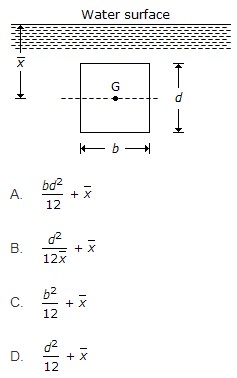11. Reynold’s number is the ratio of inertia force to
A. pressure force
B. elastic force
C. gravity force
D. viscous force
12. The unit of dynamic viscosity in S.I. units is
A. N-m/s2
B. N-s/m2
C. poise
D. stoke
13. Bulk modulus of a fluid __________ as the pressure increases.
A. remains same
B. decreases
C. increases
14. The hydraulic gradient line may be above or below the center line of the pipe.
A. True
B. False
15. A water tank contains 1.3 m deep water. The pressure exerted by the water per meter length of the tank is
A. 2.89 kN
B. 8.29 kN
C. 9.28 kN
D. 28.9 kN
16. The specific gravity has no units.
A. Agree
B. Disagree
17. The depth of water in a channel corresponding to the minimum specific energy is known as critical depth.
A. Agree
B. Disagree
18. The ratio of the inertia force to the gravity force is called Froude number.
A. Agree
B. Disagree
19. Which of the following statement is wrong?
A. A flow whose streamline is represented by a curve is called two dimensional flow.
B. The total energy of a liquid particle is the sum of potential energy, kinetic energy and pressure energy.
C. The length of divergent portion in a venturimeter is equal to the convergent portion.
D. A pitot tube is used to measure the velocity of flow at the required point in a pipe.
20. A vertically immersed surface is shown in the below figure. The distance of its center of pressure from the water surface is
